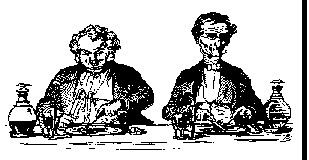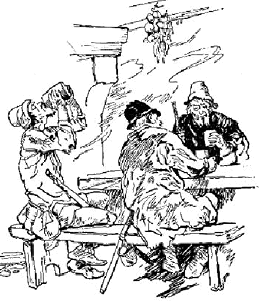Curmudgeon's Cookery -
English Menu
![]()
 Amblonguss Pie
Amblonguss Pie
"Take 4 pounds of fresh Amblongusses, and put them in a small pipkin. Cover them with water and boil them for 8 hours incessantly, after which add 2 pints of new milk, and proceed to boil for 4 hours more.
When you have ascertained that the Amblongusses are quite soft, take them out and place them in a wide pan, taking care to shake them well previously. Grate some nutmeg over the surface, and cover them carefully with powdered gingerbread, curry-powder, and a sufficient quantity of Cayenne pepper.
Remove the pan into the next room, and place it on the floor. Bring it back again, and let it simmer for three-quarters of an hour. Shake the pan violently till all the Amblongusses have become a pale purple colour.
Then, having prepared a paste, insert the whole carefully, adding at the same time a small pigeon, 2 slices of beef, 4 cauliflowers, and any number of oysters. Watch patiently till the crust begins to rise, and add a pinch of salt from time to time.
Serve up in a clean dish, and throw the whole out of the window as fast as possible."
Edward Lear, 1870. Edward Lear was a master of nonsense verse. He is best remembered for his children's story The Owl and the Pussycat.
 Pretty Bird
Pretty Bird
In the 14th century King Richard II would sometimes serve as many as fifty swans on the weekend feast table. They were more for show than consumption as the flesh is rather tough and oily.
The swans were roasted whole and then the gilded, feathered skin replaced back on the birds for dinner display. For really royal ostentation, a miniature jeweled tiara or crown would be placed on the obliging bird's head! Foodbook James Trager.
Turchickipheascock Pie
Edward VII kitchen staff burrowed from his German heritage with a unique poultry dish. This consisted of a turkey stuffed with a chicken, then inside the chicken a pheasant, and last, inside the pheasant a woodcock. The whole transmogrified thing was baked as a pie and then served cold. Edward's chef had a staff of forty-five helpers to prepare this and other tasty things, including haggis for Scots visiting Balmoral. The Seven Centuries Cookbook. Maxime McKendry
 Giant Egg
Giant Egg
Cut away the bladder and you have--oink, oink and forty clucks--A GIANT HARD BOILED EGG! The recipe suggests serving with a vinegar sauce. I'm sure this was adopted at some point in time by the English.
Chickipig and Pigichick Recipes
As another example of creativity over culinary excellence, a medieval recipe in the 14th century Harleian Manuscript had these instructions: "Take a capon and a little pig, and smite [cut] them in the waist. Sew the hind part of one on the fore quarters of the other, and stuff, and roast, and serve them forth." Kermit McKemie mailto:kmckemie@astound.net